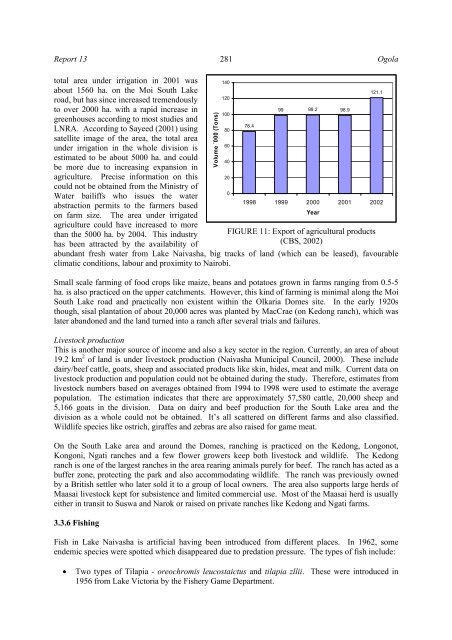appraisal drilling of geothermal wells in olkaria domes - Orkustofnun
appraisal drilling of geothermal wells in olkaria domes - Orkustofnun
appraisal drilling of geothermal wells in olkaria domes - Orkustofnun
You also want an ePaper? Increase the reach of your titles
YUMPU automatically turns print PDFs into web optimized ePapers that Google loves.
Report 13 281 Ogolatotal area under irrigation <strong>in</strong> 2001 wasabout 1560 ha. on the Moi South Lakeroad, but has s<strong>in</strong>ce <strong>in</strong>creased tremendouslyto over 2000 ha. with a rapid <strong>in</strong>crease <strong>in</strong>greenhouses accord<strong>in</strong>g to most studies andLNRA. Accord<strong>in</strong>g to Sayeed (2001) us<strong>in</strong>gsatellite image <strong>of</strong> the area, the total areaunder irrigation <strong>in</strong> the whole division isestimated to be about 5000 ha. and couldbe more due to <strong>in</strong>creas<strong>in</strong>g expansion <strong>in</strong>agriculture. Precise <strong>in</strong>formation on thiscould not be obta<strong>in</strong>ed from the M<strong>in</strong>istry <strong>of</strong>Water bailiffs who issues the waterabstraction permits to the farmers basedon farm size. The area under irrigatedagriculture could have <strong>in</strong>creased to morethan the 5000 ha. by 2004. This <strong>in</strong>dustryhas been attracted by the availability <strong>of</strong>abundant fresh water from Lake Naivasha, big tracks <strong>of</strong> land (which can be leased), favourableclimatic conditions, labour and proximity to Nairobi.Small scale farm<strong>in</strong>g <strong>of</strong> food crops like maize, beans and potatoes grown <strong>in</strong> farms rang<strong>in</strong>g from 0.5-5ha. is also practiced on the upper catchments. However, this k<strong>in</strong>d <strong>of</strong> farm<strong>in</strong>g is m<strong>in</strong>imal along the MoiSouth Lake road and practically non existent with<strong>in</strong> the Olkaria Domes site. In the early 1920sthough, sisal plantation <strong>of</strong> about 20,000 acres was planted by MacCrae (on Kedong ranch), which waslater abandoned and the land turned <strong>in</strong>to a ranch after several trials and failures.Livestock productionThis is another major source <strong>of</strong> <strong>in</strong>come and also a key sector <strong>in</strong> the region. Currently, an area <strong>of</strong> about19.2 km 2 <strong>of</strong> land is under livestock production (Naivasha Municipal Council, 2000). These <strong>in</strong>cludedairy/beef cattle, goats, sheep and associated products like sk<strong>in</strong>, hides, meat and milk. Current data onlivestock production and population could not be obta<strong>in</strong>ed dur<strong>in</strong>g the study. Therefore, estimates fromlivestock numbers based on averages obta<strong>in</strong>ed from 1994 to 1998 were used to estimate the averagepopulation. The estimation <strong>in</strong>dicates that there are approximately 57,580 cattle, 20,000 sheep and5,166 goats <strong>in</strong> the division. Data on dairy and beef production for the South Lake area and thedivision as a whole could not be obta<strong>in</strong>ed. It’s all scattered on different farms and also classified.Wildlife species like ostrich, giraffes and zebras are also raised for game meat.On the South Lake area and around the Domes, ranch<strong>in</strong>g is practiced on the Kedong, Longonot,Kongoni, Ngati ranches and a few flower growers keep both livestock and wildlife. The Kedongranch is one <strong>of</strong> the largest ranches <strong>in</strong> the area rear<strong>in</strong>g animals purely for beef. The ranch has acted as abuffer zone, protect<strong>in</strong>g the park and also accommodat<strong>in</strong>g wildlife. The ranch was previously ownedby a British settler who later sold it to a group <strong>of</strong> local owners. The area also supports large herds <strong>of</strong>Maasai livestock kept for subsistence and limited commercial use. Most <strong>of</strong> the Maasai herd is usuallyeither <strong>in</strong> transit to Suswa and Narok or raised on private ranches like Kedong and Ngati farms.3.3.6 Fish<strong>in</strong>gVolume ´000 (Tons)14012010080604020FIGURE 11: Export <strong>of</strong> agricultural products(CBS, 2002)Fish <strong>in</strong> Lake Naivasha is artificial hav<strong>in</strong>g been <strong>in</strong>troduced from different places. In 1962, someendemic species were spotted which disappeared due to predation pressure. The types <strong>of</strong> fish <strong>in</strong>clude:0• Two types <strong>of</strong> Tilapia - oreochromis leucostaictus and tilapia zllii. These were <strong>in</strong>troduced <strong>in</strong>1956 from Lake Victoria by the Fishery Game Department.78.499 99.2 98.9121.11998 1999 2000 2001 2002Year
















